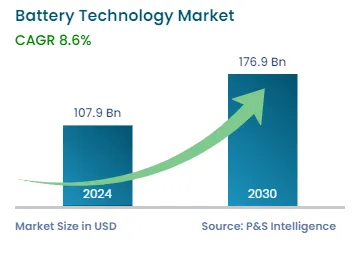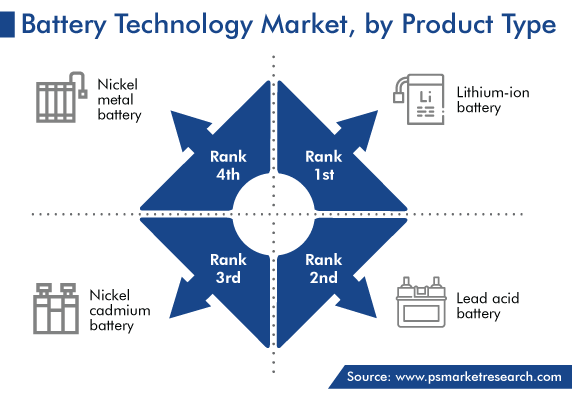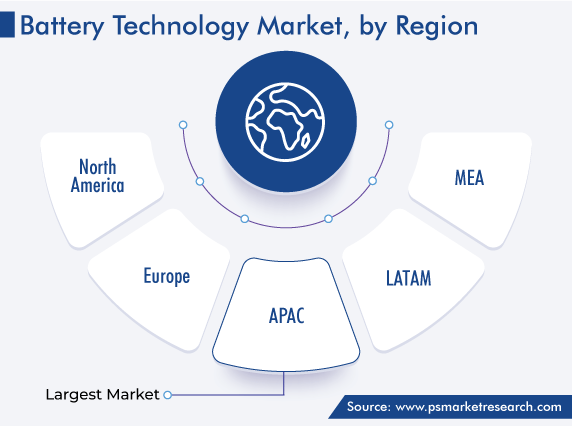Market Statistics
| Study Period | 2019 - 2030 |
| 2024 Market Size | USD 107.9 Billion |
| 2030 Forecast | USD 176.92 Billion |
| Growth Rate(CAGR) | 8.6% |
| Largest Region | Asia-Pacific |
| Fastest Growing Region | Europe |
| Nature of the Market | Fragmented |
Report Code: 12537
Get a Comprehensive Overview of the Battery Technology Market Report Prepared by P&S Intelligence, Segmented by Product Type (Lead Acid, Li-Ion, Ni-Cd, Nickel Metal) Control Technology (Battery Chargers, Battery Conditioners, Smart Battery System) Power Capacity (0 to 3K mAH, 3K to 10K mAH, 10K to 60K mAH, >60K mAH) Power System (Fuel Cell, PEMFC, AFCs, PAFCs, SOFC, MCFC, Air Cells, FES, Nuclear Batteries), Application (Automotive, Medical, Residential & Commercial, Industrial, Consumer Electronics, Power & Utility), and Geographic Regions. This Report Provides Insights from 2019 to 2030.
| Study Period | 2019 - 2030 |
| 2024 Market Size | USD 107.9 Billion |
| 2030 Forecast | USD 176.92 Billion |
| Growth Rate(CAGR) | 8.6% |
| Largest Region | Asia-Pacific |
| Fastest Growing Region | Europe |
| Nature of the Market | Fragmented |

Explore the market potential with our data-driven report
The global battery technology market size stood at USD 107.9 billion in 2024, which is expected to reach USD 176.9 billion by 2030, advancing at a CAGR of 8.6% between 2024 and 2030. The industry is expanding as a result of increasing demand for automotive applications and the rising need for consumer electronics, such as LCDs, smartphones, tablets, and wearable technology like fitness bands.
Moreover, the market is expected to significantly expand in the coming years, as a result of technological advancements in terms of increased efficiency, cost-effectiveness, and product innovation. Additionally, manufacturers are doing research and development to create durable and safer batteries because data centers have a high need for sophisticated batteries.
Due to the constantly expanding need for watches, toys, remote controls, and electronic keys around the world, the demand for battery technologies is projected to have high growth. Primary batteries are used in these items. Furthermore, it is predicted that the surging need for secondary and solid-state batteries in the automotive and aviation industries would propel the growth of the market.
Government efforts to reduce vehicle carbon emissions are propelling the sales of electric vehicles and the usage of renewable energy. For instance, the U.S. government has supported the electric vehicle (EV) and renewable energy industries, which has increased the need for battery energy storage systems (BESSs) and battery management systems (BMSs), mostly driven by lithium-ion batteries. EVs are increasingly adopted throughout the country. Along with other nations like Canada, which has already started upgrading its transportation infrastructure for electric vehicles, the U.S. is one of the top-selling markets for electric automobiles globally.
In addition, due to the considerable usage of fuel cells in the electric automobile and renewable energy sectors, it is projected that the demand for battery technologies would rise in the coming years. Also, the expanding corporate and governmental activities for the transition to various renewable energy sources are therefore expected to result in a significant requirement for this technology in the years to come. It is used in many automation systems and different battery-operated equipment in various sectors. Therefore, it is predicted that widespread usage of these technologies would significantly fuel the expansion of the market.
Based on battery type, the market is categorized into lead-acid batteries, lithium-ion batteries, nickel-cadmium batteries, nickel-metal batteries, and others. Among these, lithium-ion batteries held the largest revenue share in 2022. This is due to the rising demand for these batteries in battery electric vehicles and plug-in hybrid electric vehicles around the world. In the near future, it is projected that the rising popularity of electric vehicles among consumers would accelerate the use of lithium-ion batteries, as they are a more environmentally friendly alternative to conventional fuels. Further, the sales of EVs are being fueled by surging government activities, including incentives and subsidies, to promote their adoption.
Moreover, due to the increasing applications in uninterrupted power supply (UPS) systems, communication systems, and transport vehicles, the lead-acid batteries category accounted for the second-largest revenue share in 2022. In addition, the need for lead-acid batteries will be driven by the extensive use of continuous power supply devices in the oil and gas, healthcare, and chemical industries for consistent power delivery. Because of their great dependability and inexpensive price, these batteries are employed in essential applications.
Furthermore, throughout the projection period, the lead-acid category is projected to witness the highest growth rate. These batteries are becoming more popular, due to their lower cost and a higher level of safety as compared to lithium-ion batteries. In addition, lithium-ion batteries react with water and have a high vulnerability, which makes them dangerous. Because of safety concerns, lead-acid batteries may become more popular as a replacement for lithium-ion batteries.

Based on the application segment, the market is categorized into automotive, medical, residential & commercial, industrial, consumer electronics, power & utility, and others. Among these, the automotive category held the largest revenue share in 2022. This is attributed to the high adoption of battery technologies, the increased R&D expenditure, and the rise in the development of sustainable travel options, in the automotive sector. In addition, governments’ increased emphasis on promoting the usage of commercial electric cars is projected to contribute to the market growth in this industry.
Whereas, during the projected period, it is projected that the consumer electronics category will be the most opportunistic. This can be due to the rising need for various automated and intelligent consumer electronic gadgets, such as fitness bands and smartwatches.
Drive strategic growth with comprehensive market analysis

Based on Product Type
Based on Control Technology
Based on Power Capacity
Based on Power System
Based on Application
Geographical Region
The battery technology market size stood at USD 107.9 billion in 2024.
During 2024–2030, the growth rate of the battery technology market will be around 8.6%.
Lithium-ion battery is the largest battery type in the battery technology market.
The major drivers of the battery technology market include the rising need for electric vehicles, the increasing demand for consumer electronics, and the surging research and development to create durable and safer batteries.
Want a report tailored exactly to your business need?
Request CustomizationLeading companies across industries trust us to deliver data-driven insights and innovative solutions for their most critical decisions. From data-driven strategies to actionable insights, we empower the decision-makers who shape industries and define the future. From Fortune 500 companies to innovative startups, we are proud to partner with organisations that drive progress in their industries.
Working with P&S Intelligence and their team was an absolute pleasure – their awareness of timelines and commitment to value greatly contributed to our project's success. Eagerly anticipating future collaborations.
McKinsey & Company
IndiaOur insights into the minutest levels of the markets, including the latest trends and competitive landscape, give you all the answers you need to take your business to new heights
We take a cautious approach to protecting your personal and confidential information. Trust is the strongest bond that connects us and our clients, and trust we build by complying with all international and domestic data protection and privacy laws
Customize the Report to Align with Your Business Objectives
Request the Free Sample Pages